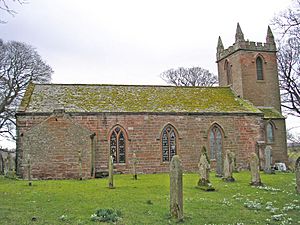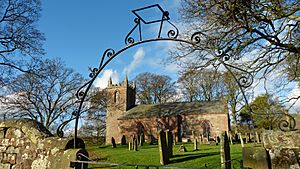St Cuthbert's Church, Dufton facts for kids
Quick facts for kids St Cuthbert's Church, Dufton |
|
|---|---|

St Cuthbert's Church, Dufton
|
|
| Lua error in Module:Location_map at line 420: attempt to index field 'wikibase' (a nil value). | |
| Location | Dufton, Cumbria |
| Country | England |
| Denomination | Anglican |
| History | |
| Status | Parish church |
| Architecture | |
| Functional status | Active |
| Architectural type | Church |
| Administration | |
| Parish | Dufton |
| Deanery | Appleby-in-Westmorland |
| Archdeaconry | Carlisle |
| Diocese | Carlisle |
| Province | York |
St Cuthbert's Church is a historic church located about three-quarters of a mile north of the village of Dufton, in Cumbria, England. It is an active Anglican church, meaning it is part of the Church of England. This church is a parish church, serving the local community of Dufton. It is also part of a larger group of ten parishes called the "Heart of Eden."
The church is found north-west of Dufton village. The name Dufton means 'dove farm'. The church sits below the eastern hills, near the beautiful Eden Valley. It is about 3 miles north of Appleby and 12 miles south-east of Penrith. From the churchyard, you can see amazing views of Dufton Pike and the Pennine mountains.
Contents
History of St Cuthbert's Church
The churchyard of St Cuthbert's is shaped in a curve. This might mean it was first built by Celtic people a very long time ago. An old settlement called 'Old Dufton' on the hill above the village has been identified as being from Roman-British times. The first mention of 'the manor of Dufton' was in old records from 1176. The church itself was first mentioned in church tax records from 1291.
Early Beginnings and St Cuthbert
Legend says that the first church was built on a spot where monks from Lindisfarne rested. They were carrying the body of St Cuthbert while running away from Viking invaders in 865 or 866. Church records show that a rector (a type of priest) was present in 1293. The church was officially dedicated to St Cuthbert in 1366.
However, there is evidence of even older parts. Some decorative stones used in the church's rebuilding point to a building from the 1100s. These include two round window-heads and two arched stones with zigzag patterns. They are now part of the north and south walls. There is also an old Roman carving of a small figure in the south wall of the chancel. An old medieval grave slab with decorations is set into the east wall of the nave.
Building Materials and Design
The church walls are made of sandstone rubble and cut stone. The roofs are covered with slate. Inside, the church feels bright and open. There is no arch separating the main part of the church (nave) from the altar area (chancel). Instead, there is a high, slanted ceiling with decorative plaster panels that covers both areas. At the west end, there is a wooden gallery and a slim font (a basin for baptisms) underneath it.
Restorations and Changes
The church has been repaired and updated many times over the years. Major restorations happened in 1673, 1784, and 1853. The work in 1784 likely included building the west tower and rebuilding the north wall. The 1853 restoration largely shaped how the church looks today. In 1946, the roof and the east end were rebuilt. Old stained glass was reused in the new east window. In 1983, some windows on the south side were repaired.
The bright and airy feel inside comes from the special windows. They have a pattern of clear glass mixed with brightly colored, diamond-shaped panes. These windows are believed to have been made by Faucet of Appleby around 1784. In the center of the east window, there is a dove surrounded by flames. This represents the Holy Spirit and reminds everyone that Dufton means 'dove farm'.
Gifts for the Community
Three special plaques inside the church talk about gifts given to help the poor and uneducated people of Dufton and Knock. One plaque on the north wall of the nave describes a gift from 1835. It provided "six and a half stone loaves of the finest wheaten bread" to ten poor widows or householders in Dufton. Five poor widows or householders in Knock also received this gift every Christmas Day.
Dufton's Famous Son: John Boste
Among the Forty Martyrs of England and Wales is John Boste (also known as Boast). He was honored with a plaque in the church porch. The Boste family lived in both Penrith and Dufton. Parish records show they were baptized, married, and buried in both places.
John Boste was born in Dufton in 1543. He is thought to have attended Appleby Grammar School. After studying at Queen's College, Oxford, he became a teacher there. While at Oxford, John became a Fellow, which meant he had become a priest in the Protestant Church of England.
However, John later became a Roman Catholic. He trained to be a priest in France. After becoming a priest, he secretly returned to England. He worked to serve Catholics in his home country, especially in the north.
Because of his work, he became a wanted man. He was eventually betrayed and arrested. He was taken to the Tower of London. John was charged with treason for entering the country as a Catholic priest and for celebrating Mass. He was tried in Durham and sentenced to death on July 24, 1594. He died faithfully for his beliefs.
The church building dates back to the medieval period. It was rebuilt in 1784 and restored in 1853 and again in 1946. It is a Grade II listed building, which means it is an important historical building.
Architecture of St Cuthbert's
St Cuthbert's Church is built in the Gothic style. This style is known for its pointed arches, ribbed vaults, and large windows.
See also
- Listed buildings in Dufton


